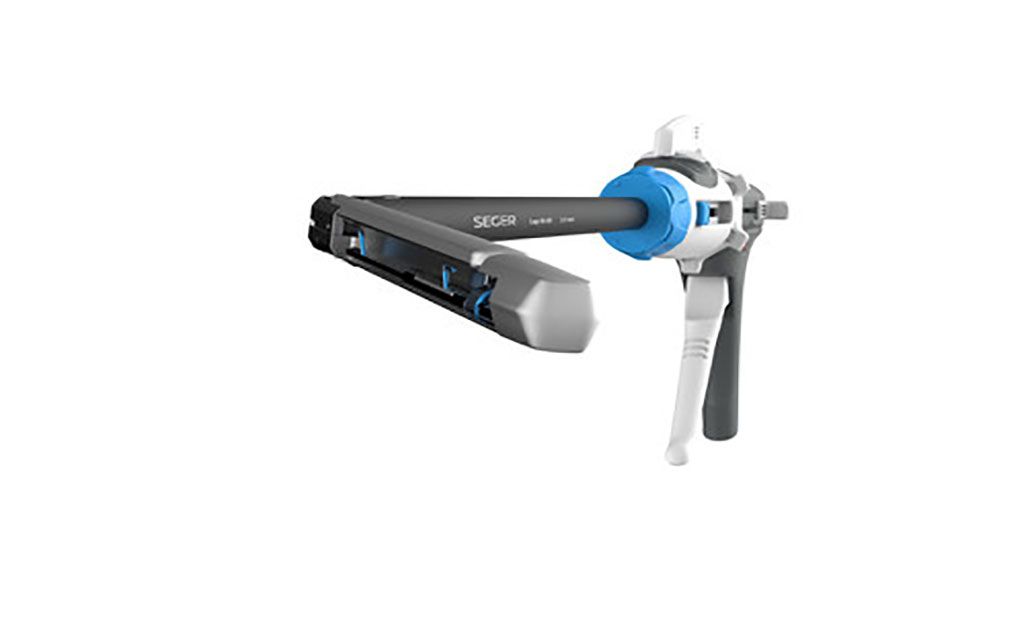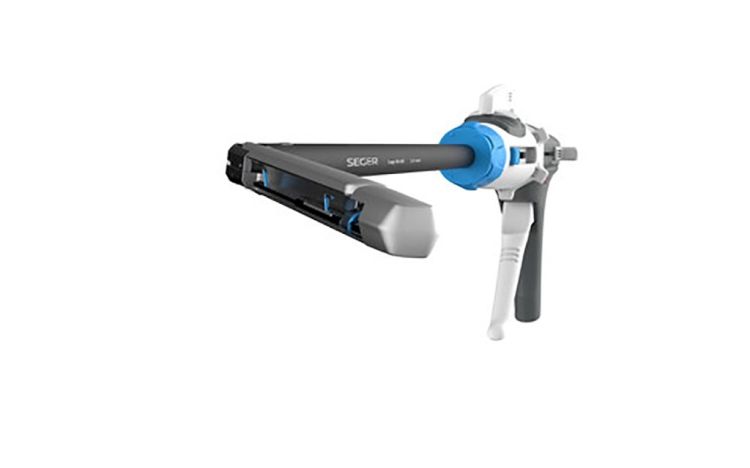Next Generation Laparoscopic Stapler

A next-generation laparoscopic stapler for intracorporeal anastomosis allows simple, quick closure for the typical enterotomy.
The unique tool has been established by Seger Surgical Solutions Ltd. (Misgav, Israel) which has effectively completed pet studies and is verifying the device for human tests and FDA clearance.
Digestive tract resection surgical procedure includes getting rid of a section of the intestinal tract. Following resection, the doctor creates a typical opening (enterotomy) in the two digestive tract sections to link them (anastomosis). Laparoscopic digestive tract resection and anastomosis are chosen over open surgical treatment due to scientific benefits to the patient and also procedure rate. Currently, most resections and also anastomoses are carried out outside the abdomen (extracorporeal) as a result of the difficulties of laparoscopic suturing. Extracorporeal anastomosis has actually been shown to lead to longer healthcare facility remains and increased hospital stay costs because of post-operative difficulties, consisting of higher post-op rupture prices with midline cuts, boosted discomfort, as well as worse cosmesis due to larger cuts.
Laparoscopic surgery has revolutionized the field of surgery, enabling surgeons to perform procedures through small incisions. Laparoscopic staplers have played a crucial role in the advancement of laparoscopic surgery, allowing surgeons to perform stapling and cutting procedures with greater ease and precision. The Next Generation Laparoscopic Stapler is a significant advancement in laparoscopic surgery, providing increased precision and control during stapling procedures. This essay will discuss the features and benefits of the Next Generation Laparoscopic Stapler.
What is the Next Generation Laparoscopic Stapler?
The Next Generation Laparoscopic Stapler is a surgical instrument that enables surgeons to perform stapling and cutting procedures during laparoscopic surgery. The instrument consists of a handle, a shaft, and a jaw. The handle provides a comfortable grip, while the shaft allows the instrument to be maneuvered through small incisions. The jaw is used to staple and cut tissues during the procedure.
Features of the Next Generation Laparoscopic Stapler:
Articulating Technology
The Next Generation Laparoscopic Stapler has a unique articulating technology that enables the instrument to move in a natural, ergonomic manner. The articulating technology allows the instrument to move in a 360-degree range of motion, providing the surgeon with increased dexterity and precision.
Ergonomic Handle
The handle of the Next Generation Laparoscopic Stapler is ergonomically designed to provide a comfortable grip for the surgeon. The handle is made of a lightweight material that reduces hand fatigue and allows for a secure grip.
Lightweight Shaft
The shaft of the Next Generation Laparoscopic Stapler is made of a lightweight material that enables the instrument to be maneuvered through small incisions. The lightweight shaft also reduces hand fatigue and allows for more precise movements.
Versatile Jaw
The jaw of the Next Generation Laparoscopic Stapler is designed to be versatile and can be used to staple and cut tissues during the procedure. The jaw is also interchangeable, allowing the surgeon to use different types of jaws for different procedures.
Integrated Firing System
The Next Generation Laparoscopic Stapler has an integrated firing system that enables the surgeon to fire the instrument with a single hand movement. The firing system reduces the risk of misfiring and provides increased control during the stapling and cutting procedures.
Benefits of the Next Generation Laparoscopic Stapler:
Increased Dexterity and Precision
The Next Generation Laparoscopic Stapler enables surgeons to perform stapling and cutting procedures with increased dexterity and precision. The articulating technology and versatile jaw allow the surgeon to maneuver the instrument with greater ease, enabling them to perform procedures with greater accuracy and control.
Reduced Hand Fatigue
The lightweight design of the Next Generation Laparoscopic Stapler reduces hand fatigue, allowing surgeons to perform procedures for longer periods without experiencing discomfort. The ergonomic handle also provides a comfortable grip, further reducing hand fatigue.
Improved Patient Outcomes
The increased dexterity and precision provided by the Next Generation Laparoscopic Stapler can result in improved patient outcomes. The instrument allows for more precise movements, reducing the risk of complications and improving the accuracy of the procedure.
Versatility
The Next Generation Laparoscopic Stapler is versatile and can be used for a variety of laparoscopic procedures. The interchangeable jaw allows the surgeon to use different types of jaws for different procedures, making the instrument suitable for a wide range of surgeries.
Improved Efficiency
The increased dexterity and precision provided by the Next Generation Laparoscopic Stapler can also result in improved efficiency. The instrument allows the surgeon to perform procedures more quickly and accurately, reducing the time required for the procedure and improving the overall efficiency of the surgical team.
Comparison with Traditional Laparoscopic Stapler:
The Next Generation Laparoscopic Stapler provides several advantages over traditional laparoscopic staplers. Traditional laparoscopic staplers have limited mobility, and the surgeon's hand movements are restricted by the size of the instrument. The Next Generation Laparoscopic Stapler's articulating technology and versatile jaw provide increased dexterity and precision during stapling and cutting procedures, reducing the risk of complications and improving patient outcomes.
The ergonomic handle and lightweight shaft of the Next Generation Laparoscopic Stapler reduce hand fatigue, allowing the surgeon to perform procedures for longer periods without experiencing discomfort. Traditional laparoscopic staplers can cause hand fatigue and discomfort, resulting in longer procedure times and reduced efficiency.
The integrated firing system of the Next Generation Laparoscopic Stapler provides increased control during stapling and cutting procedures, reducing the risk of misfiring and improving the accuracy of the procedure. Traditional laparoscopic staplers require multiple hand movements to fire the instrument, increasing the risk of misfiring and reducing the accuracy of the procedure.
Conclusion:
The Next Generation Laparoscopic Stapler is a significant advancement in laparoscopic surgery, providing increased dexterity and precision during stapling and cutting procedures. The instrument's articulating technology, ergonomic handle, lightweight shaft, versatile jaw, and integrated firing system provide several benefits, including reduced hand fatigue, improved patient outcomes, and improved efficiency. The Next Generation Laparoscopic Stapler's advantages over traditional laparoscopic staplers make it a valuable addition to the surgical team, improving patient outcomes and reducing the risk of complications.






